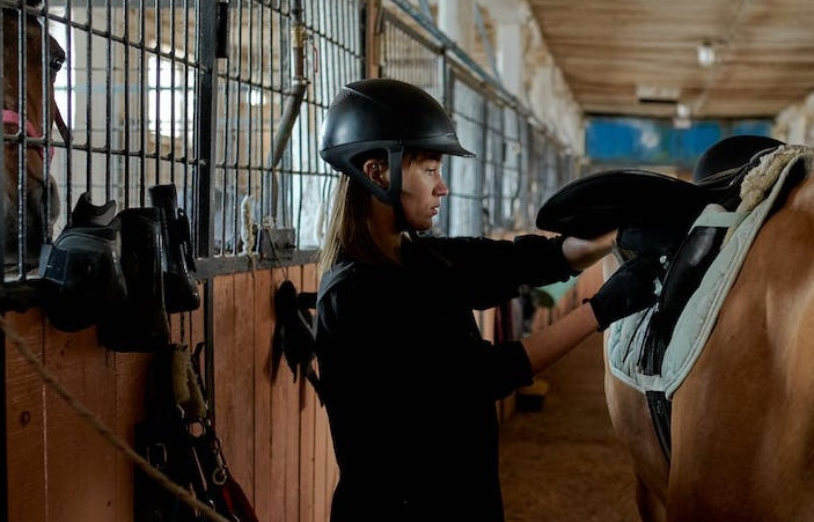If you own a horse, you’re likely to have a whole wardrobe of equipment that comes as part of the package. A saddle and bridle at the very least, plus undoubtedly some rugs for various climates, grooming kit, and various other accessories. Whether you keep your horses at livery or at home, with farms and stables at a high risk on the rural crime scale, how do you keep your tack and equipment safe, and make sure it doesn’t go walkabouts?
It will be unlikely that livery yards will have cover within their insurance policies for any tack and equipment left on the premises by their clients, this will be the responsibility of the owner. Your tack may be covered under your horse policy, or a separate tack policy. Either way, it’s important to ensure you have the correct cover in place for all of the items you own, to check policy limits or exclusions, and that they are suitably stored.
So, what are the considerations for storing your tack securely?
Keeping it in a Communal Tack Room
If your yard offers a tack room, its important to ensure that it meets your insurers criteria for security in terms of your tack and equipment cover. In the event of an insurance claim, insurance companies may need proof of the access procedures for the tack room, the lock type and any other precautions taken to deter theft.
This can often include the structure type of the building itself, who it is that has access or certain criteria to be met in terms of windows or locks. The more precautions in place, the more secure your tack will be. Ideally, any tack rooms should have a single-entry point, with a good quality lock, be windowless (or have window bars), dry, well-lit and be of a self-contained solid structure.
Keeping it in a Private Tack Locker
A tack locker could be used independently, or within a communal tack room and can offer a higher level of individual security in terms of restricting who has access to your belongings. But are there any specific rules for insurance in terms of this. Is your tack locker left in such a place that it would be lifted and carried away with ease?
If you have a portable tack locker that you move between your horse box and the yard, ensure that when not in use this is securely fixed such as bolted to the floor in the yard or in your lorry as otherwise it could simply be wheeled away. You could also consider other security measures such as additional chains or locks to prevent to door being opened by unauthorised persons.
Keeping it in Your Horse Box
Especially for those who compete regularly, it may be convenient to leave certain tack or equipment in their horse box, either in the living compartment or in internally or externally accessed tack lockers. But are your tack and equipment insured if that is the case? On your tack cover is it insured to be left in the horsebox, or is it covered as contents on your horsebox cover? These are the questions you need to ask, especially if you’re leaving high value items in the horsebox.
It is also important to keep access restricted to the horsebox whilst at shows or events, and ensure it is fully locked when left unattended. It would also be worthwhile checking the insurance cover for your tack and equipment whilst you are on the road. To say if you were the victim of a theft whilst at a show or elsewhere.
If you use your horsebox for storage, then it is also wise to consider that if your horsebox is stolen, you will also lose anything inside!
Keeping it at Home
For those who perhaps do not have a tack room available at the yard, who prefer not to leave it in communal areas, or who keep their horses at home they may take their tack, rugs and any larger equipment in their house and transport to the yard only when necessary. Again, its important to understand the insurance implications of this and under which insurance policy the cover may fall during both storage and transport, as there is a high percentage of time the tack may also be in your vehicle- so would this fall under your tack insurance, your car insurance, or your home insurance?
If it is covered under your home insurance, then you would need to ensure not only that it meets the criteria for the security and access aspects of theft prevention, but that it is also covered when being transported and when it is stored at the yard, and to correctly declare to your insurer the value of any items, to ensure you do not surpass any single item limit, and to check times when it may not be covered.
Keeping it in Your Car
Often , people will transport tack home to store, clean or perhaps some other reason, and some people even keep their tack in their car full time, but is your tack covered whilst on the move? Most insurance policies will not cover any tack or equipment if it is stolen from an unlocked car, and any tack should also be well covered and out of sight. It would be sensible to keep the time your tack is in your vehicle to a minimum, and for transportation to and from the yard only.
General Yard Security
It’s also worth considering the overall yard security as well. Is the yard ‘open to all’, is the tack room readily accessible and unlocked, are there security cameras, tack room alarms or other security systems in place, are any locks or closures of high quality, are the buildings well maintained, are there procedures in place to deal with fires or other eventualities that could put anything on the yard at risk…
To help reduce the risks, only keep what is necessary at the yard. If there are items that you only use for show days, at certain times of the year, or infrequently then its best to only take these to the yard when you need them. It will reduce the risk of loss or damages, and save storage space, but you must make sure that wherever you store them when not in use, they are still appropriately stored, and insured one way or another.
General Storage Guidance
You also need to make sure that wherever you choose to store your equipment is suitable. For any leather goods, its important that they are not stored in damp condition, nor somewhere too dry, to prevent damage to the leather and risk of breaking or deterioration over time. Equally for fabric products such as saddle cloths, rugs and boots you don’t want these to be stored where they may get damp, or where there may be risk of damage from vermin. Ideally, all items should be cleaned before storage, and then stored in suitably to prevent them getting damaged, dirty, or decayed whilst not in use.
We all hear tales of unintentional equipment sharing on yards, so its also important to put items away when you are finished with them. We’ve also all heard takes of tack and equipment going ‘walkabouts’ on yards never to be seen again, which is why its important to mark your items and always put them away!
Proof of Ownership
It is also wise to mark your tack and equipment so that they are easily identifiable. It also always an idea to, where possible, buy items that stand out in terms of colour or design to make them easily identifiable and reduce the likelihood of any mix ups. This can not only be a good deterrent but can also help identify your tack or equipment to prove ownership in the event of theft.
There are schemes such as HorseWatch that offer tack stamping/ marking services, or DIY kits can be bought to do this yourself for stamping, engraving or UV marker pens. You can also use ‘covert’ marking systems such as smart water, DNA based systems or microchipping. Rugs and other equipment can easily be marked in indelible ink or with paint (such as rugs, boots and suchlike).
It is also wise to keep an inventory of your most important tack and equipment, any receipts providing purchase or value, and have good quality photographs of all your higher value equipment such as tack, rugs, show equipment and the like in case this is ever needed for an insurance claim.
The main goal is to ensure you try to take every possible precaution to prevent the theft or damage of your tack and equipment, and in the event of theft, to aid its recovery and identification..
It’s important to remember that the exact insurance requirements will be determined by your specific insurer, and the level of cover that you have. It is therefore ideal to use this information as a guide only, and to ask your own insurer about any specific requirements or guidance they need you to follow to ensure your tack and equipment is appropriately insured under their policy.
You can find more guidance and support relating to yard security, client management and general yard management on the LiveryList Yard Owner Hub at www.yardownerhub.co.uk



